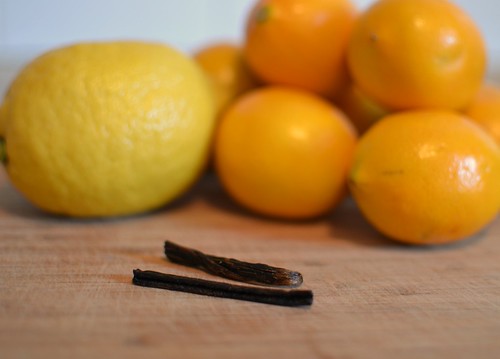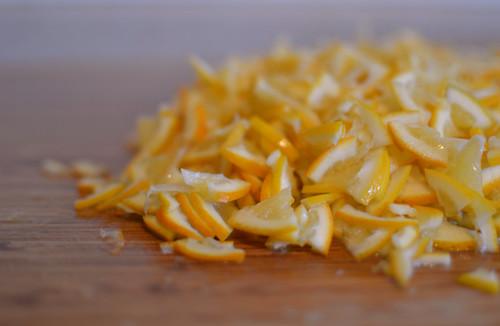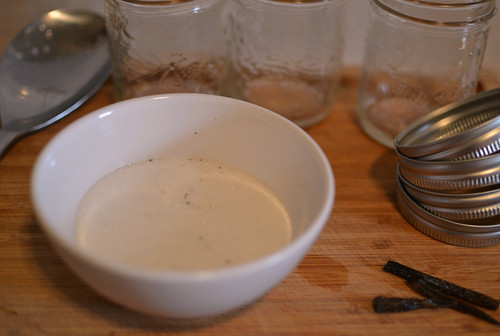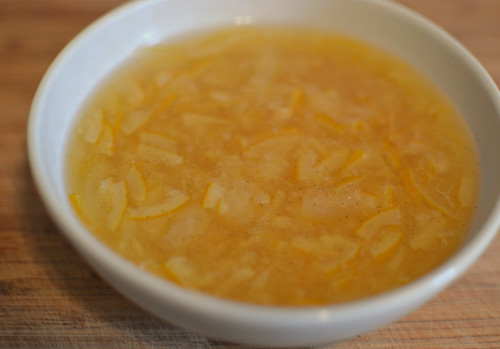
This one is Meyer lemon and vanilla, which it looks like the whole internet was making a few years ago but I just got around to it now. Seven Meyer lemons, one regular ol' lemon, two-thirds of a vanilla bean, two and a half cups each of water and sugar, easy.

I thought that a more delicate flavour deserved a more delicate preparation than I have used for my other bigger bolder marmalades this year, so these lemons got a slightly more exacting treatment than my Moros or Sevilles. I topped and tailed the fruit, sliced it into lengthwise eighths, cut out the pith from the centre of the fruit, cut away the exposed membranes between sections of flesh, and sliced it into wedges 1/16" thick.

The Epicurious recipe I linked above tells you to discard the lemon seeds, which is obviously a travesty—put them in a muslin bag and add them to the boiling fruit, because their pectin is very useful! Another thing it doesn't mention but I think is a good idea: instead of scraping the vanilla seeds directly into the pot, scrape them into about a quarter-cup of the sugar you'll be adding and rub it in thoroughly with your fingers. This is to ensure even distribution of seeds throughout the marmalade, no clumps allowed.

The smaller pieces of fruit mean that this marmalade is more like slivers of peel suspended in lemon and vanilla jelly than chunks of peel held together by just-barely-enough jelly, as is my usual preference. It's good to have a variety of textures!

I feel like I'm further along the marmalade learning curve than I was at this time last year—now I am better at coaxing out the fullest flavours and preserving the fruit's bright colours. I can't decide whether my favourite is the bright yellow one from today or last week's coral-coloured one.

Today at my neighbourhood grocery store the cara cara oranges were cheap and plentiful, so I got a few. They are for bright pink jam though, not marmalade, so it's totally different.
2 comments:
Your marmalade looks gorgeous. I'm curious about the recipe you use - all the ones I've seen are for large batches.
I use a volume ratio! 1 part chopped fruit (this includes flesh and peel) to 1 part liquid (any juice you catch from chopping fruit, plus water to make up the total volume) to 1 part sugar (this measurement is a bit elastic; a little more sugar for very sweet marmalade, a little less for more bitter, and it also depends on the sweetness of the fruit—taste the peel after its overnight soak but before you put it on the heat and proceed by intuition). If you prefer and have a scale handy, you can use 70% of the weight of the fruit in sugar, with the same caveat about varying the amount according to taste. I made a marmalade-related photoset here that shows my preparation and cooking procedure if you are curious.
Smaller amounts will cook faster, so if you're making, like, two lemons' worth of preserves, it is a good idea to have all your canning equipment prepped and jars ready to go before you put the fruit on the heat. If you are making a very small batch that you want to start eating immediately, you are totally permitted to just decant it to a clean jar and put it in the fridge, where it will keep basically indefinitely. Anyway, small batches are awesome if you want fifty thousand different varieties of everything like I do, or if you are the only person in your apartment who eats marmalade, also like me. The usual batches I make range from two to four 250mL jars.
Marmalade is a very encouraging preserve to make using a rough volume ratio and intuition because the fruit already contains all the pectin you need, so you don't need to worry about what proportion of a box to add. Thin-skinned citrus (e.g. key limes or the noble Meyer lemon) is a little less likely to set up solidly all on its own, but you can always supplement with a standard lemon like I did for this marmalade (which I am eating on toast at this very second and it is THE DELICIOUS).
Post a Comment